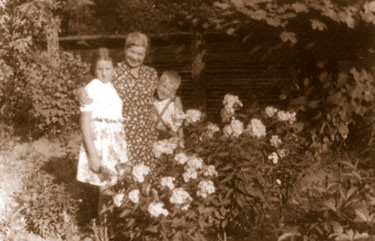
Volume VI, Issue VII
A 'Best of THYMEs' Feature...
THYME's 'Esther of the Year'
Irena Sendler Has Died at 98 [click to read]
This week the 'other' weekly news magazine presents: The Childfree Life [click to read]. Children, you see, get in the way when you want to "have it all!" THYME this week goes back in history to examine the life of a woman who truly knew the value of children. Her story proves it.
The 'other' weekly news magazine has its 'Person of the Year.' WORLD Magazine has its 'Daniel of the Year,' so this year THYME will have its Esther. Esther, you may recall was the young girl who saved the Jewish people from extermination by the wicked Haman in the Persian Empire of Xerxes. The feast of Purim joyfully celebrates the deliverance.
A Twentieth Century Esther might have gone unnoticed but for the work of four students at Uniontown High School, in Kansas, who discovered her story. The Play: Life in a Jar is the result of their research. Elizabeth Cambers, Megan Stewart, Sabrina Coons and Janice Underwood, four high school girls, are responsible for bringing this woman's amazing life to light.
Irena Sendler was born in 1910 in Otwock, Poland, fifteen miles outside of Warsaw. Her Father was a doctor and most of his patients were poor Jews. Undoubtedly Ms. Sendler was influenced by her Father's compassion for his patients. When the Germans invaded Poland in 1939, Irena was a Senior Administrator in the Warsaw Social Welfare Department, which provided meals, financial aid, and other services for orphans, the elderly, the poor and the destitute of the City. She enrolled Jewish families under fictitious names and often used quarantine for such infectious diseases as typhus and tuberculosis to keep nosy officials at bay.
In 1942, however, the Nazis walled off sixteen blocks of Warsaw, herded Jewish families in, and created the horrific Warsaw Ghetto.
Horrified by this new development, Sendler joined Zegota, the Council for Aid to Jews, organized by the Polish underground resistance movement, and recruited ten of her friends to help her. In order to get into the Ghetto, she obtained a pass from Warsaws Epidemic Control Department and posed as a health worker. Sanitation and basic services were lacking. The Nazis saw little need to provide these things, but were concerned about the possibility of disease epidemics that might escape the Ghetto.
Irena was deeply moved by the plight of the babies and children. Initially she and her fellow workers smuggled in food, clothing and medicine as they performed their work as sanitation workers, but knowing that 5000 people a month were dying in the Ghetto, Irena was compelled to do far more. She and her 'fellow employees' smuggled babies in their tool boxes, older children in sacks and boxes on their trucks. They often sedated the children so they would be quiet but she is said to have used a dog on one of her trucks who would bark menacingly whan soldiers would approach to inspect it. The soldiers had no desire to get close to the dog and left the interior of the truck unsearched.
Sendler, a young Mother herself, had to convince other Mothers to hand her their babies and children. One Mother asked her: "Can you guarantee my child will live?" Her answer was the harsh truth that if the child stayed, he would surely die. "In my dreams," she once said, "I still hear the cries when they left their parents."
"Irena Sendler accomplished her incredible deeds with the active assistance of the church. "I sent most of the children to religious establishments," she recalled. "I knew I could count on the Sisters." Irena also had a remarkable record of cooperation when placing the youngsters: "No one ever refused to take a child from me," -- Jewish Virtual Library
Most of the children who left with Sendler's group were taken into Roman Catholic convents, orphanages and homes and given non-Jewish aliases. Sendler kept the only record of their true identities in the hope that one day she could restore them to their families. The names of 2500 rescued children were placed in jars which Sendler buried under a neighbor's apple tree.
On October 20, 1943, the Gestapo, who were becoming increasingly aware of her activities, arrested Irena Sendler. Even under torture -- they broke her legs and feet [1.] -- she refused to give up those names. She was sentenced to be executed but her friends bribed officials and she was able to escape.
After the war Irena dug up the jars and worked to reunite children with their families. Sadly many had no family to go to anymore. The woman they had known only as 'Jolanta' was sad that she could have not done more for them.
Honored by international Jewish organizations - in 1965 she was accorded the title of Righteous Among the Nations by the Yad Vashem organization in Jerusalem. In 1991 she was made an honorary citizen of Israel.
Irena Sendler was awarded Poland's highest distinction, the Order of White Eagle. She died at the age of 98 on May 12, 2008.
Source: The Telegraph [click to read] and Jewish Virtual Library [click to read].

Irena Sendler with her children, Janka and Adam.
The Ignoble Nobel
It is reported that Irena Sendler was nominated for the Nobel Peace Prize. Although nominees names are kept from publication there is good reason to believe she was recently passed up in the process. The prize went to Albert Arnold Gore for a slide show on 'Global Warming.' In an era where world leaders routinely deny that the Holocaust happened, and portray the most speculative 'science' as proven truth this should not come as a great surprise.
We should never allow the popular narrative to erase the truth and heroism of women like Irena Sendler and the message their stories hold for us.
Holocaust Can't Happen Again [click to read], can it? Thoughts from Arnold Ahlert in Jewish World Review.
THYME's 2012 'Esther of the Year'
"...and who knoweth whether thou art come to the kingdom for such a time as this?" -- Esther 4:14
Last Year THYME's 'Esther of the Year' was Irena Sendler [click to read]. This amazing woman saved the lives of many children during the holocaust. This year, with great sadness, we remember another woman's saving of children. She was not a great public figure, she did not seek fame. Her Mother said of her: "She was not somebody that ever wanted to be famous or wanted her picture in the paper."
So we will simply remember her deeds. 2012 'Esther of the Year' [click to read].





No comments:
Post a Comment